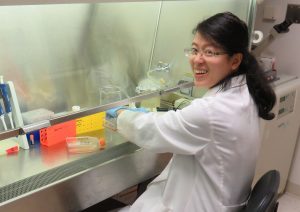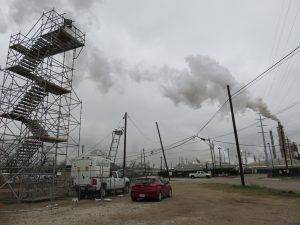Researchers identify new methodology for examining changes in lung cells after pollution exposure
October 12, 2016

Hang Nguyen analyzes lung cells that were exposed to toxic gases. (Photo credit: Ken Sexton)
Hang Nguyen, MS, doctoral student of environmental science and engineering in the UNC Gillings School of Global Public Health, is first author of a recent study that provided the initial test of a new methodology for examining the genomic response of lung cells to real-world mixtures of air pollutants.
Most current studies do not assess cellular impact in relation to real-world atmospheric combinations of gases. Because many gases – including federally regulated toxic compounds categorized as hazardous air pollutants (HAPs) – transform into different gas species once they are released into the atmosphere, understanding the true health risks of exposure requires studies to be conducted on complex mixtures of fresh and oxidized gases that cannot be replicated in the laboratory setting.
In this study, Nguyen and colleagues examined the feasibility of measuring lung cells’ biological responses upon direct exposure to air in the field.
Other co-authors from the Gillings School are William Vizuete, PhD, associate professor, Kenneth G. Sexton, PhD, former research assistant professor, Lisa Smeester, tissue culture specialist, and Rebecca C. Fry, PhD, associate professor, all with the Department of Environmental Sciences and Engineering.
The full article, titled, “From the Field to the Laboratory: Air Pollutant-Induced Genomic Effects in Lung Cells,” was published online Feb. 18 by Environmental Health Insights.

A cell exposure and monitoring lab (at left) overlooks a refinery in the Houston Shipping Channel. (Photo credit: Ken Sexton)
For their experiment, the researchers deployed lung cells in the heavily industrialized Houston Shipping Channel. This release marked the first time a study has brought lung cells outside for contact with real-world conditions. After collecting the exposed cells, the investigators identified changes in specific genes that play a role as inflammatory responders in the cell.
The results showed anticipated responses from both negative and positive controls, confirming the integrity of the experimental protocol and the successful deployment of the study instrument. Additionally, the exposure to ambient field conditions caused robust changes in the lung cells’ gene expression, demonstrating that the novel methodology can produce gas-phase toxicity data.
Future research will expand upon this study to examine other biological responses to measured atmospheric pollutants.
HAPs, including benzene and formaldehyde, are associated with respiratory disease, increased cancer risk and other adverse health effects. The methodology’s greatest potential for public health, therefore, lies in producing field data that will allow researchers to determine which pollutants are most important to overall air toxicity, and how those pollutants impact affected populations.
This study was part of a larger field campaign, the Benzene and other Toxics Exposure Study, and was funded by the Houston Advanced Research Center.
Gillings School of Global Public Health contact: David Pesci, director of communications, (919) 962-2600 or dpesci@unc.edu
